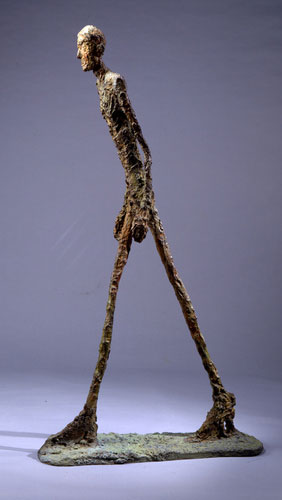Contribute
| South Asian Art - How To Identify Good Art |
07/08/2010
In February 2010, an Alberto Giacometti sculpture – the Walking Man sold for 65 million pounds at Sotheby’s auction. This was an unexpectedly high amount compared to modest 18 million which the auction house had expected. Was the amount justified? Experts suggest that as the life-size sculpture was a ‘life-time cast’ in bronze by the renowned sculptor and as it had never been placed out in the open so it was in remarkably good condition and given the high repute of the artist as probably the best sculptor ‘of all time’ – the price was well worth it.
Which brings us to the dilemma – it is fine if the artist has made a ‘name’ for himself and his ‘signature’ has value, but how do you recognise good art when it is by an artist who is just emerging in the art arena? What exactly constitutes good art? It may be very difficult to answer this question but still one can go by some basic thumb rules while considering an artwork:
Uniqueness: An artist would of course argue that all art is unique. When we refer to uniqueness we mean that after removing the references, elements of nature or (conscious or unconscious) influences by other renowned artists, does the work reflect the artist’s own unique style and personality, is he making a new statement through his art? If you feel that the artwork and the artist are presenting something new that attracts the viewer and offers an opportunity for contemplation, then that is the first step towards it being a good artwork.
Attractive: Here we do not refer to a ‘pretty picture’. There could be thousands of landscapes and pictures of horses etc, what made those by Turner and Constable stand out and be noteworthy was that rather than being just bland reproductions they radiated life, and hinted at the unseen. The ‘attraction’ here is the desire to explore the artwork further, the ability of the paintings to hold your attention. If you see a painting and can walk past it without having to retrace your steps for a second glance – dismiss it outright as a ‘good’ artwork.
Technical aspects: To a lay person the technical aspects of art would be a mystery, but it is still possible to figure out the basics of technique when viewing a painting. The balance in the work, the colour, composition, use of light, the brushwork, the use of layers to create depth, the way the artist leads the viewer’s eyes through the artwork all contribute towards the making of ‘good’ art. This is perhaps why few self-taught artists do not achieve greatness because they are lacking in the study of the basics of technique.
There are other aspects of course, it would be naive to state that ‘good art’ is defined by just the three observations listed above, but they represent a beginning or focal point. Great art is that which is capable of evoking strong emotional reaction which could be positive or negative. The works by Damien Hirst for instance tend to appal most viewers but at least even in that they are eliciting a response. The most humiliating experience for an artist would be if the only response to his or her work were indifference.
Alberto Giacometti sculpture – the Walking Man
Earlier, there was a popular belief, that artists die poor and later their works claim phenomenal prices. This was mainly because for art to be recognised and be given the mark of a ‘masterpiece’ it has to be able to stand the test of time and be ‘relevant’ in any era. It should transcend beyond the limits of subject, theme, and political leanings and present universality in its uniqueness. This is why perhaps in modern times it very difficult to label an artwork as a masterpiece, though there is plenty of ‘good art’ only because not enough time has lapsed!
On a more humorous note, a study has shown that one could even leave the selection of good art from bad to pigeons! Professor Shigeru Watanabe, from Keio University in Japan, said his work showed pigeons judge beauty in a similar way to humans. The birds study the colour, pattern and texture of watercolour and pastel paintings and decide whether they are "good" or "bad". They were able to successfully pick out good paintings when shown a selection of work by school children. So now, science proves that art is not just for the human soul but also for the birds!
You may also access this article through our web-site http://www.lokvani.com/
